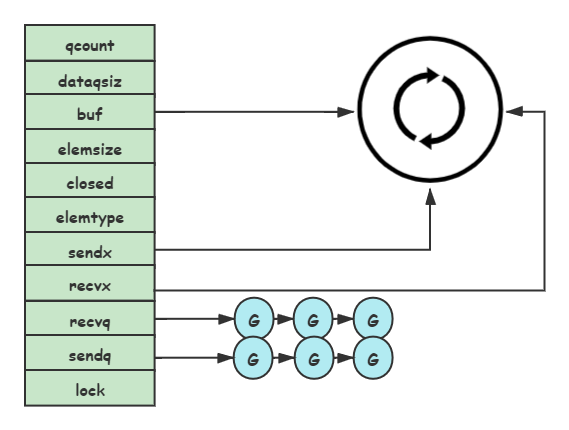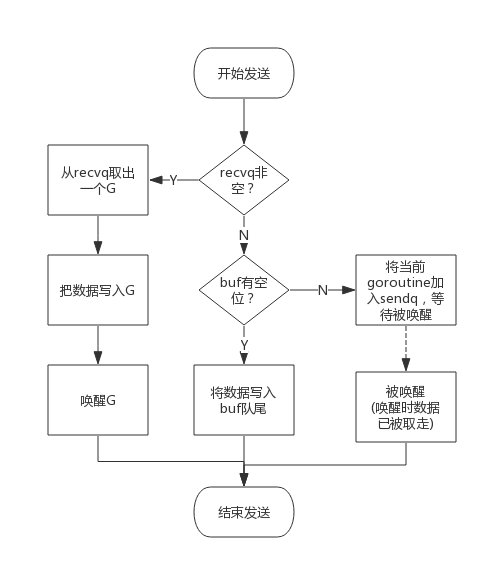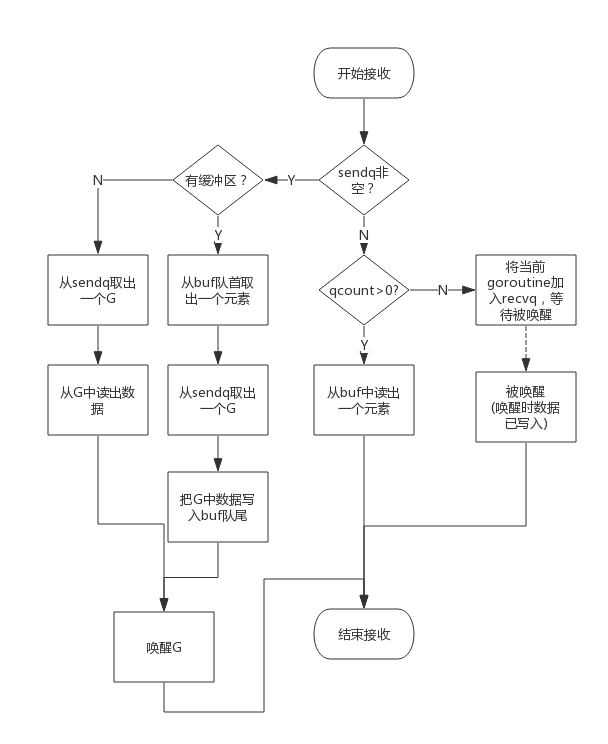Go源码阅读——runtime.chan
1. chan结构体定义
1
2
3
4
5
6
7
8
9
10
11
12
13
14
15
16
17
18
19
20
| type hchan struct {
qcount uint
dataqsiz uint
buf unsafe.Pointer
elemsize uint16
closed uint32
elemtype *_type
sendx uint
recvx uint
recvq waitq
sendq waitq
lock mutex
}
type waitq struct {
first *sudog
last *sudog
}
|
可以看到,chan底层就是一个循环队列。
2. chan的创建
在 Go 中我们使用 make(chan T, cap) 来创建 channel,make 语法会在编译时,转换为 makechan64 和 makechan:
1
2
3
4
5
6
7
| func makechan64(t *chantype, size int64) *hchan {
if int64(int(size)) != size {
panic(plainError("makechan: size out of range"))
}
return makechan(t, int(size))
}
|
makechan64 主要是做了一下检查,最终还是会调用 makechan ,在看 makechan 源码之前,我们先来看两个全局常量,接下来会用到:
1
2
3
4
| const (
maxAlign = 8
hchanSize = unsafe.Sizeof(hchan{}) + uintptr(-int(unsafe.Sizeof(hchan{}))&(maxAlign-1))
)
|
maxAlign 是内存对齐的最大值,这个等于 64 位 CPU 下的 cacheline 的大小hchanSize 计算 unsafe.Sizeof(hchan{}) 最近的 8 的倍数
2.1. #真正创建chan——#makechan
1
2
3
4
5
6
7
8
9
10
11
12
13
14
15
16
17
18
19
20
21
22
23
24
25
26
27
28
29
30
31
32
33
34
35
36
37
38
39
40
| func makechan(t *chantype, size int) *hchan {
elem := t.elem
if elem.size >= 1<<16 {
throw("makechan: invalid channel element type")
}
if hchanSize%maxAlign != 0 || elem.align > maxAlign {
throw("makechan: bad alignment")
}
mem, overflow := math.MulUintptr(elem.size, uintptr(size))
if overflow || mem > maxAlloc-hchanSize || size < 0 {
panic(plainError("makechan: size out of range"))
}
var c *hchan
switch {
case mem == 0:
c = (*hchan)(mallocgc(hchanSize, nil, true))
c.buf = c.raceaddr()
case elem.ptrdata == 0:
c = (*hchan)(mallocgc(hchanSize+mem, nil, true))
c.buf = add(unsafe.Pointer(c), hchanSize)
default:
c = new(hchan)
c.buf = mallocgc(mem, elem, true)
}
c.elemsize = uint16(elem.size)
c.elemtype = elem
c.dataqsiz = uint(size)
lockInit(&c.lock, lockRankHchan)
return c
}
|
因此,创建的过程可以总结为如下:
- 创建时会做一些检查
- 元素大小不能超过 64K
- 元素的对齐大小不能超过 maxAlign 也就是 8 字节
- 计算出来的内存是否超过限制
- 创建时的策略
- 如果是无缓冲的 channel,会直接给 hchan 分配内存
- 如果是有缓冲的 channel,并且元素不包含指针,那么会为 hchan 和底层数组分配一段连续的地址
- 如果是有缓冲的 channel,并且元素包含指针,那么会为 hchan 和底层数组分别分配地址
3. 发送数据
3.1. 发送数据前检查——#chansend
我们在 x <- chan T 进行发送数据的时候最终会被编译成 chansend1:
1
2
3
| func chansend1(c *hchan, elem unsafe.Pointer) {
chansend(c, elem, true, getcallerpc())
}
|
而 chansend1 最终还是调用了 chansend 主要的逻辑都在 chansend 上面,注意看下方源码和注释:
1
2
3
4
5
6
7
8
9
10
11
12
13
14
15
16
17
18
19
20
21
22
23
24
25
26
27
28
29
30
31
32
33
34
35
36
37
38
39
40
41
42
43
44
45
46
47
48
49
50
51
52
53
54
55
56
57
58
59
60
61
62
63
64
65
66
67
68
69
70
71
72
73
74
75
76
77
78
79
80
81
82
83
84
85
86
87
88
89
90
91
92
93
94
95
96
97
98
99
100
101
102
103
104
105
106
107
108
109
110
111
112
|
func chansend(c *hchan, ep unsafe.Pointer, block bool, callerpc uintptr) bool {
if c == nil {
if !block {
return false
}
gopark(nil, nil, waitReasonChanSendNilChan, traceEvGoStop, 2)
throw("unreachable")
}
if !block && c.closed == 0 && full(c) {
return false
}
lock(&c.lock)
if c.closed != 0 {
unlock(&c.lock)
panic(plainError("send on closed channel"))
}
if sg := c.recvq.dequeue(); sg != nil {
send(c, sg, ep, func() { unlock(&c.lock) }, 3)
return true
}
if c.qcount < c.dataqsiz {
qp := chanbuf(c, c.sendx)
typedmemmove(c.elemtype, qp, ep)
c.sendx++
if c.sendx == c.dataqsiz {
c.sendx = 0
}
c.qcount++
unlock(&c.lock)
return true
}
if !block {
unlock(&c.lock)
return false
}
gp := getg()
mysg := acquireSudog()
mysg.releasetime = 0
if t0 != 0 {
mysg.releasetime = -1
}
mysg.elem = ep
mysg.waitlink = nil
mysg.g = gp
mysg.isSelect = false
mysg.c = c
gp.waiting = mysg
gp.param = nil
c.sendq.enqueue(mysg)
gopark(chanparkcommit, unsafe.Pointer(&c.lock), waitReasonChanSend, traceEvGoBlockSend, 2)
KeepAlive(ep)
if mysg != gp.waiting {
throw("G waiting list is corrupted")
}
gp.waiting = nil
gp.activeStackChans = false
if gp.param == nil {
if c.closed == 0 {
throw("chansend: spurious wakeup")
}
panic(plainError("send on closed channel"))
}
gp.param = nil
if mysg.releasetime > 0 {
blockevent(mysg.releasetime-t0, 2)
}
mysg.c = nil
releaseSudog(mysg)
return true
}
|
3.2. 如果有goroutine急着接收数据——#send
1
2
3
4
5
6
7
8
9
10
11
12
13
14
15
16
17
| func send(c *hchan, sg *sudog, ep unsafe.Pointer, unlockf func(), skip int) {
if sg.elem != nil {
sendDirect(c.elemtype, sg, ep)
sg.elem = nil
}
gp := sg.g
unlockf()
gp.param = unsafe.Pointer(sg)
if sg.releasetime != 0 {
sg.releasetime = cputicks()
}
goready(gp, skip+1)
}
|
3.3. 发送数据总结
向 channel 中发送数据时大概分为两大块,检查和数据发送,而数据发送又分为三种情况:
- 如果 channel 的
recvq 存在阻塞等待的接收数据的 goroutine 那么将会直接将数据发送给第一个等待的 goroutine
- 这里会直接将数据拷贝到
x <-ch 接收者的变量 x 上
- 然后将接收者的 Goroutine 修改为可运行状态,并把它放到发送方所在处理器的 runnext 上等待下一次调度时执行。
- 如果 channel 是有缓冲的,并且缓冲区没有满,这个时候就会把数据放到缓冲区中
- 如果 channel 的缓冲区满了,这个时候就会走阻塞发送的流程,获取到 sudog 之后将当前 Goroutine 挂起等待唤醒,唤醒后将相关的数据解绑,回收掉 sudog
4. 接收数据
在 Go 中接收 channel 数据有两种方式
x <- ch 编译时会被转换为 chanrecv1x, ok <- ch 编译时会被转换为 chanrecv2
chanrecv1 和 chanrecv2 没有多大区别,只是 chanrecv2 比 chanrecv1 多了一个返回值,最终都是调用的 chanrecv 来实现的接收数据
1
2
3
4
5
6
7
8
9
10
11
12
13
14
15
16
17
18
19
20
21
22
23
24
25
26
27
28
29
30
31
32
33
34
35
36
37
38
39
40
41
42
43
44
45
46
47
48
49
50
51
52
53
54
55
56
57
58
59
60
61
62
63
64
65
66
67
68
69
70
71
72
73
74
75
76
77
78
79
80
81
82
83
84
85
86
87
88
89
90
91
92
93
94
95
96
97
98
99
100
101
102
103
104
105
106
107
108
109
110
111
112
113
114
115
116
117
118
119
120
121
122
|
func chanrecv(c *hchan, ep unsafe.Pointer, block bool) (selected, received bool) {
if c == nil {
if !block {
return
}
gopark(nil, nil, waitReasonChanReceiveNilChan, traceEvGoStop, 2)
throw("unreachable")
}
if !block && empty(c) {
if atomic.Load(&c.closed) == 0 {
return
}
if empty(c) {
if ep != nil {
typedmemclr(c.elemtype, ep)
}
return true, false
}
}
lock(&c.lock)
if c.closed != 0 && c.qcount == 0 {
unlock(&c.lock)
if ep != nil {
typedmemclr(c.elemtype, ep)
}
return true, false
}
if sg := c.sendq.dequeue(); sg != nil {
recv(c, sg, ep, func() { unlock(&c.lock) }, 3)
return true, true
}
if c.qcount > 0 {
qp := chanbuf(c, c.recvx)
if ep != nil {
typedmemmove(c.elemtype, ep, qp)
}
typedmemclr(c.elemtype, qp)
c.recvx++
if c.recvx == c.dataqsiz {
c.recvx = 0
}
c.qcount--
unlock(&c.lock)
return true, true
}
if !block {
unlock(&c.lock)
return false, false
}
gp := getg()
mysg := acquireSudog()
mysg.releasetime = 0
if t0 != 0 {
mysg.releasetime = -1
}
mysg.elem = ep
mysg.waitlink = nil
gp.waiting = mysg
mysg.g = gp
mysg.isSelect = false
mysg.c = c
gp.param = nil
c.recvq.enqueue(mysg)
gopark(chanparkcommit, unsafe.Pointer(&c.lock), waitReasonChanReceive, traceEvGoBlockRecv, 2)
if mysg != gp.waiting {
throw("G waiting list is corrupted")
}
gp.waiting = nil
gp.activeStackChans = false
if mysg.releasetime > 0 {
blockevent(mysg.releasetime-t0, 2)
}
closed := gp.param == nil
gp.param = nil
mysg.c = nil
releaseSudog(mysg)
return true, !closed
}
|
4.1. 如果有goroutine急着发送数据——#recv
1
2
3
4
5
6
7
8
9
10
11
12
13
14
15
16
17
18
19
20
21
22
23
24
25
26
27
28
29
30
31
32
33
34
35
36
| func recv(c *hchan, sg *sudog, ep unsafe.Pointer, unlockf func(), skip int) {
if c.dataqsiz == 0 {
if ep != nil {
recvDirect(c.elemtype, sg, ep)
}
} else {
qp := chanbuf(c, c.recvx)
if ep != nil {
typedmemmove(c.elemtype, ep, qp)
}
typedmemmove(c.elemtype, qp, sg.elem)
c.recvx++
if c.recvx == c.dataqsiz {
c.recvx = 0
}
c.sendx = c.recvx
}
sg.elem = nil
gp := sg.g
unlockf()
gp.param = unsafe.Pointer(sg)
if sg.releasetime != 0 {
sg.releasetime = cputicks()
}
goready(gp, skip+1)
}
|
4.2. 接收数据总结
数据接收和发送其实大同小异,也是分为检查和数据接收,数据接收又分三种情况
- 直接获取数据,如果当前有阻塞的发送者 Goroutine 走这条路
- 如果是无缓冲 channel,直接从发送者那里把数据拷贝给接收变量
- 如果是有缓冲 channel,并且 channel 已经满了,就先从 channel 的底层数组拷贝数据,再把阻塞的发送者 Goroutine 的数据拷贝到 channel 的循环队列中
- 从 channel 的缓冲中获取数据,有缓冲 channel 并且缓存队列有数据时走这条路
- 阻塞接收,剩余情况走这里
- 和发送类似,先获取当前 Goroutine 信息,构造 sudog 加入到 channel 的 recvq 上
- 然后休眠当前 Goroutine 等待唤醒
- 唤醒后做一些清理工作,释放 sudog 返回
5. 关闭chan
我们使用 close(ch) 来关闭 channel 最后会调用 runtime 中的 closechan 方法:
1
2
3
4
5
6
7
8
9
10
11
12
13
14
15
16
17
18
19
20
21
22
23
24
25
26
27
28
29
30
31
32
33
34
35
36
37
38
39
40
41
42
43
44
45
46
47
48
49
50
51
52
53
54
55
56
57
58
59
60
61
62
63
64
65
| func closechan(c *hchan) {
if c == nil {
panic(plainError("close of nil channel"))
}
lock(&c.lock)
if c.closed != 0 {
unlock(&c.lock)
panic(plainError("close of closed channel"))
}
c.closed = 1
var glist gList
for {
sg := c.recvq.dequeue()
if sg == nil {
break
}
if sg.elem != nil {
typedmemclr(c.elemtype, sg.elem)
sg.elem = nil
}
if sg.releasetime != 0 {
sg.releasetime = cputicks()
}
gp := sg.g
gp.param = nil
glist.push(gp)
}
for {
sg := c.sendq.dequeue()
if sg == nil {
break
}
sg.elem = nil
if sg.releasetime != 0 {
sg.releasetime = cputicks()
}
gp := sg.g
gp.param = nil
if raceenabled {
raceacquireg(gp, c.raceaddr())
}
glist.push(gp)
}
unlock(&c.lock)
for !glist.empty() {
gp := glist.pop()
gp.schedlink = 0
goready(gp, 3)
}
}
|
5.1. 关闭chan总结
- 关闭一个 nil 的 channel 和已关闭了的 channel 都会导致 panic
- 关闭 channel 后会释放所有因为 channel 而阻塞的 Goroutine
6. 案例说明(好案例)
1
2
3
4
5
6
7
8
9
10
11
12
13
14
15
16
17
18
19
| func gA(a <-chan int) {
val := <-a
fmt.Println("g1 received data:", val)
return
}
func gB(b <-chan int) {
val := <-b
fmt.Println("g2 received data:", val)
return
}
func main() {
ch := make(chan int)
go gA(ch)
go gB(ch)
ch <- 3
time.Sleep(time.Second)
}
|
首先创建了一个无缓冲的 channel,接着启动两个 goroutine,并将前面创建的 channel 传递进 去。然后,向这个 channel 中发送数据 3,最后 sleep 1 秒后程序退出。
7. 问题
7.1. 如果channel为nil,从这个channel中接收数据会怎么样?
- 在非阻塞模式下,会直接返回
- 在阻塞模式下,会调用
gopark挂起goroutine,并且会一直阻塞下去
8. 关闭一个为nil的channel会怎么样?
关闭一个nil的channel或者一个已经关闭的channel都会导致panic
9. channel什么情况下会引起资源的泄露?
channel资源泄露的原因是goroutine操作channel之后,处于发送或者接收阻塞状态,而channel处于满或者空的状态,一直得不到改变。他同时,垃圾回收器也不会回收这部分的资源,就会导致goroutine一直处于等待的状态。
9.1. channel何时被GC收集?
如果一个channel没有任何goroutine引用,GC就会对其进行回收操作。





